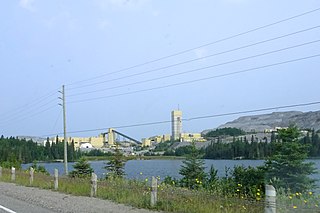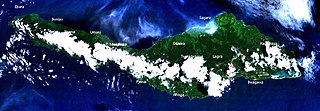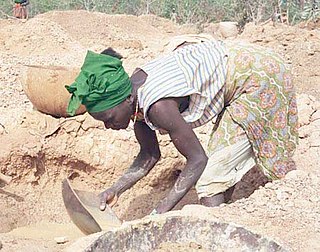Freeport-McMoRan Inc., often called Freeport, is an American mining company based in the Freeport-McMoRan Center, in Phoenix, Arizona. The company is the world's largest producer of molybdenum, a major copper producer and operates the world's largest gold mine, the Grasberg mine in Papua, Indonesia.

Barrick Gold Corporation is a mining company that produces gold and copper with 16 operating sites in 13 countries. It is headquartered in Toronto, Ontario, Canada. It has mining operations in Argentina, Canada, Chile, Côte d'Ivoire, Democratic Republic of the Congo, Dominican Republic, Mali, Papua New Guinea, Saudi Arabia, Tanzania, the United States and Zambia. In 2023, it produced 4.05 million ounces of gold at all-in sustaining costs of $1,335/ounce and 420 million pounds of copper at all-in sustaining costs of $3.21/pound. As of 31 December 2023, the company had 77 million ounces of proven and probable gold reserves.
Placer Dome Inc. was a large mining company specializing in gold and other precious metals, with corporate headquarters in Vancouver, British Columbia, Canada.

Newcrest Mining Limited is an Australian-based corporation which engages in the exploration, development, mining and sale of gold and the froth flotation product, gold-copper concentrate. It is Australia's leading gold mining company and its operations have expanded beyond Australia, for example Indonesia, thus becoming a prominent international mining corporation. Newmont initially started the company as a subsidiary in 1966. The subsidiary became Newmont Holdings Pvt Ltd in 1980 and in 1990 acquired 100 per cent of Australmin Holdings Limited taking the current name.

Misima is a volcanic island in the northwest of Louisiade Archipelago within Milne Bay Province of Papua New Guinea.

Harmony Gold is the largest gold mining company in South Africa. Harmony operates in South Africa and in Papua New Guinea. The company has nine underground mines, one open-pit mine and several surface operations in South Africa. In Papua New Guinea, it has Hidden Valley, an open-pit gold and silver mine and a 50% interest in the Morobe Mining Joint Venture, which includes the Wafi-Golpu project and extensive exploration tenements. Outside the joint venture, Harmony's own exploration portfolio focuses principally on highly prospective areas in Papua New Guinea.

The Ok Tedi Mine is an open-pit copper and gold mine in Papua New Guinea located near the headwaters of the Ok Tedi River, in the Star Mountains Rural LLG of the North Fly District of the Western Province of Papua New Guinea.
Gold Ridge is a gold mine on Guadalcanal, Solomon Islands, about 30 km (19 mi) southeast of the capital Honiara. Civil unrest caused closure for two years soon after opening in 1998. After several changes of hands since the 1990s, and under foreign ownership until its closure in 2014, the mine is now owned by Gold Ridge Mining Limited (GRML), which includes a 10% stake in its ownership by landowner-controlled company GoldRidge Community Investment Limited (GCIL).

The Porgera Gold Mine is a large gold and silver mining operation near Porgera, Enga province, Papua New Guinea (PNG). Located at the head of the Porgera Valley, The mine is situated in the rain forest covered highlands at an altitude of 2,200 to 2,700 m, in a region of high rainfall, landslides, and frequent earthquakes.

Mining in Papua New Guinea is an important part of the Papua New Guinea economy.
Mount Fubilan was a mountain in the Western Province of Papua New Guinea. It has been removed in the course of the excavation of the Ok Tedi Mine, which been developed since 1984 as an open-pit copper and gold mine. After decades of mining, the mountain has been replaced by a massive pit in the ground.
A parochial political culture is a political culture where citizens have only limited awareness of the existence of central government. Parochial culture leads to the general ignorance about political subjects and a consequent lack of involvement of political activity. It may occur in regions where traditionally-stateless societies are subject to the jurisdiction of a state, their limited awareness of the law contributing to the power dynamics between such communities and their state.
African Rainbow Minerals Limited is a mining company based in South Africa. ARM has interests in a wide range of mines, including platinum and platinum group metals (PGMs), iron, coal, copper, and gold. ARM's Goedgevonden coalmine near Witbank is a flagship of their joint venture with Xstrata, and produces 6.7 million tons of coal per year. Production is expanding at the Two Rivers platinum mine in Mpumalanga. ARM owns 20% of Harmony Gold, the 12th largest gold mining company in the world with three mining operations in South Africa. Patrice Motsepe is the executive chairman; Phillip Tobias is CEO.
Nautilus Minerals Inc. was a Canadian deep sea exploration and mining company founded in 1997, and listed on the Toronto Stock Exchange between 2007 and 2019. The company was known for Solwara-1, the first deep sea mining project, an attempt to explore and mine a mineral deposit on the seabed off the coast of Papua New Guinea. By 2019, the company had faced bankruptcy and was delisted due to long-standing environmental concerns about the project and financial turmoil, resulting in its assets being owned by Deep Sea Mining Finance Limited.
Mineral Resources Development Company Limited (MRDC) was established in 1975 and is 100% owned by the Government of Papua New Guinea.
The Porgera Landowners Association (PLOA) was formed in the late 1980s and incorporated in 1992. Its objectives are to represent the 10,000 landowners with traditional land around the Porgera Gold Mine and serve as a pressure group on behalf of the landowners, and to pursue landowner claims in the courts in Port Moresby. The PLOA is funded by royalties from the mine, so that the mine pays for the institution established to oppose it.

Mining is important to the national economy of Mongolia. Mongolia is one of the 29 resource-rich developing countries identified by the International Monetary Fund and exploration of copper and coal deposits are generating substantial additional revenue.

The mining industry of Guinea was developed during colonial rule. The minerals extracted consisted of iron, gold, diamond, and bauxite. Guinea ranks first in the world in bauxite reserves and 6th in the extraction of high-grade bauxite, the aluminium ore. The mining industry and exports of mining products accounted for 17% of Guinea's gross domestic product (GDP) in 2010. Mining accounts for over 50% of its exports. The country accounts for 94% of Africa's mining production of bauxite. The large mineral reserve, which has mostly remained untapped, is of immense interest for international firms.
Nixon Koeka Mangape is a Papua New Guinean politician. He was a member of the National Parliament of Papua New Guinea from 2012 to 2017, representing the electorate of Lagaip-Porgera Open.
Maso Karipe was a Papua New Guinean politician of the Pangu Party.







